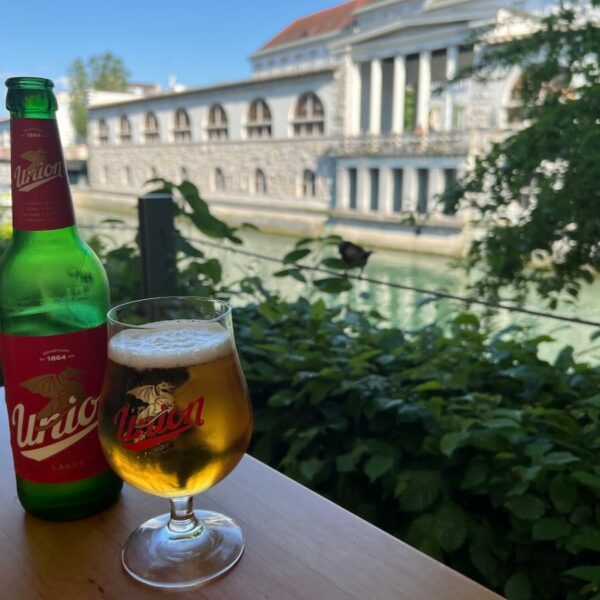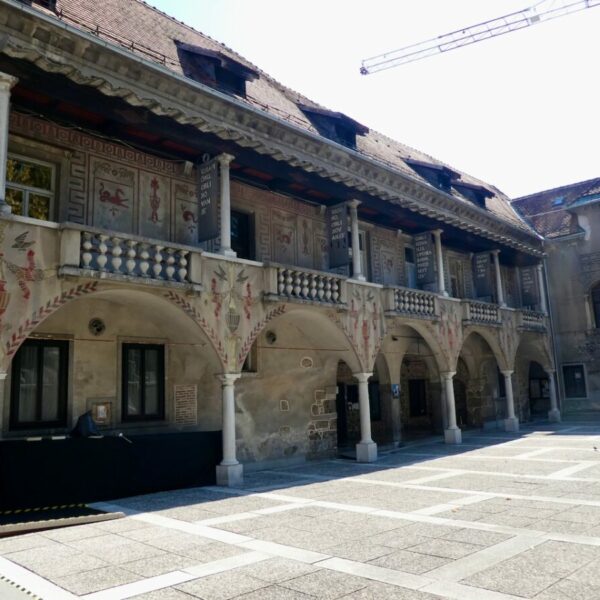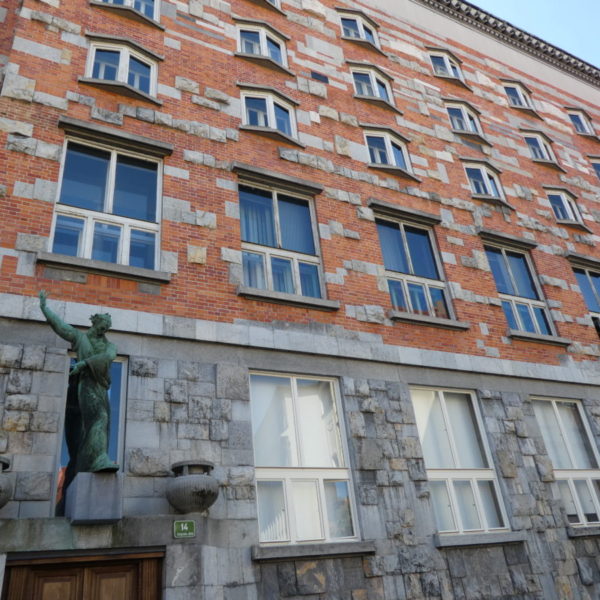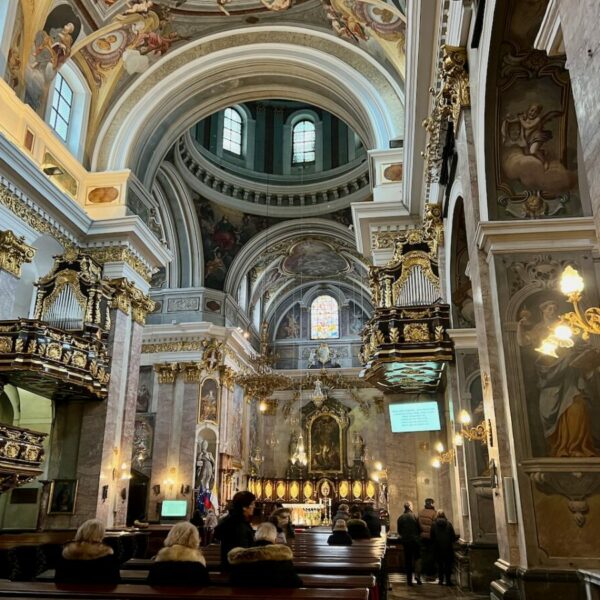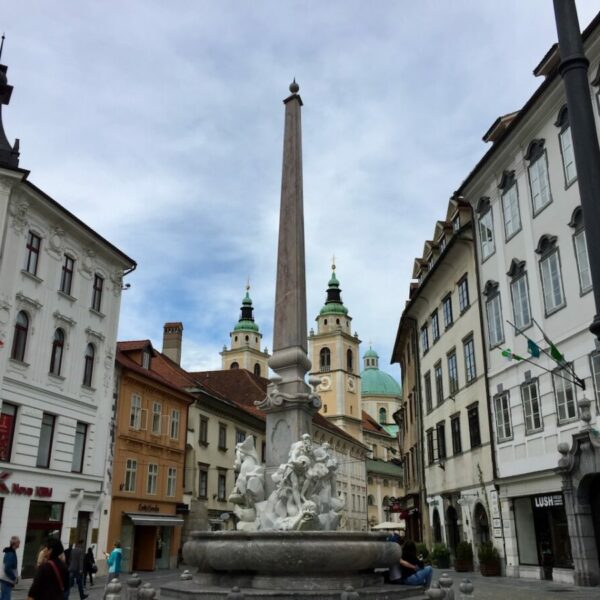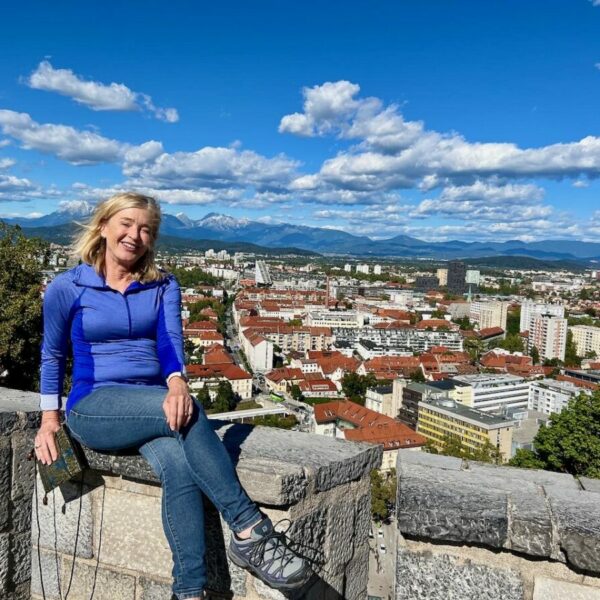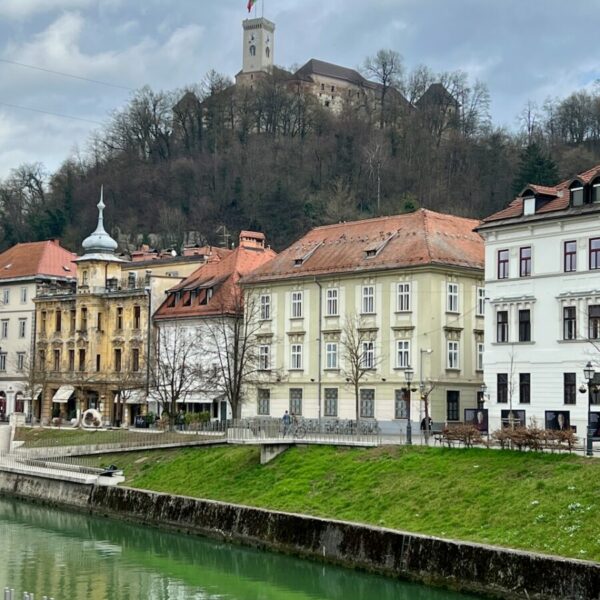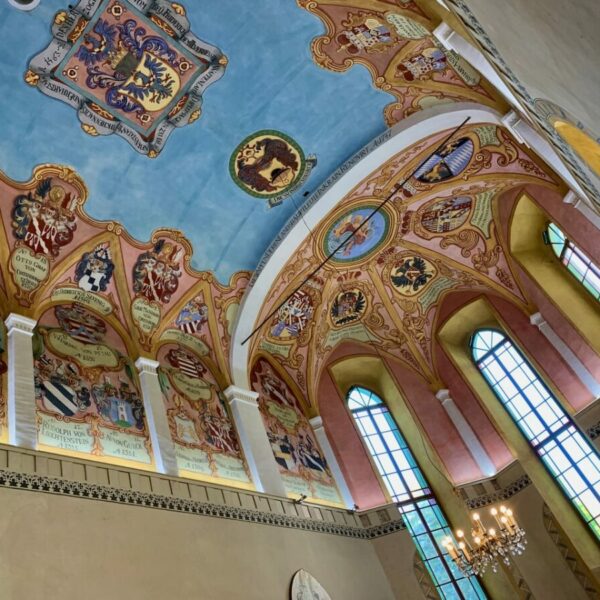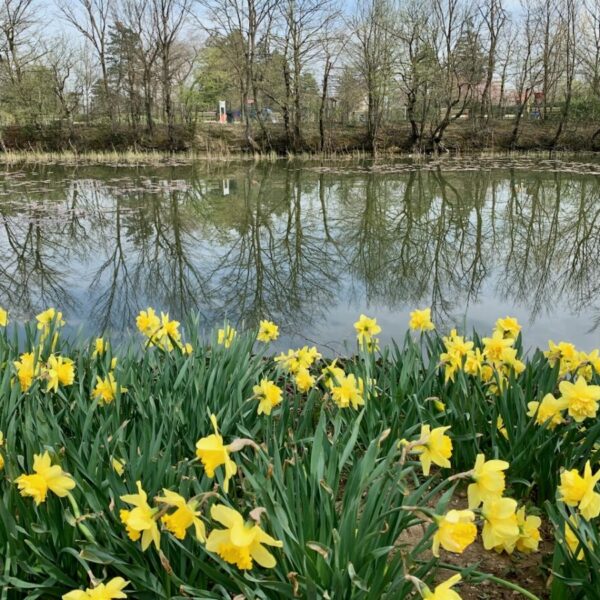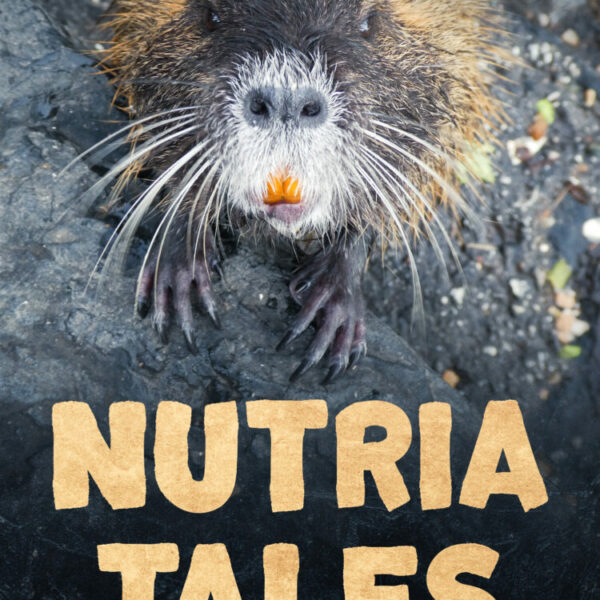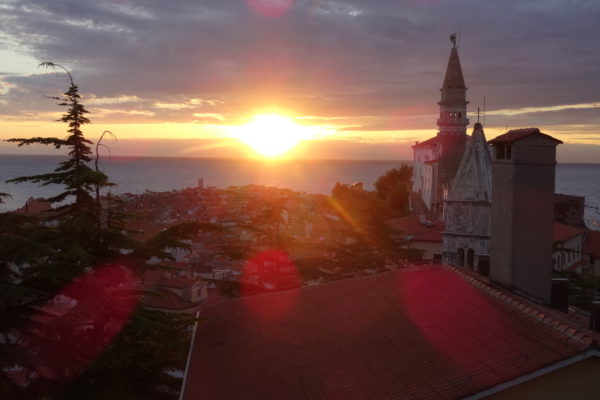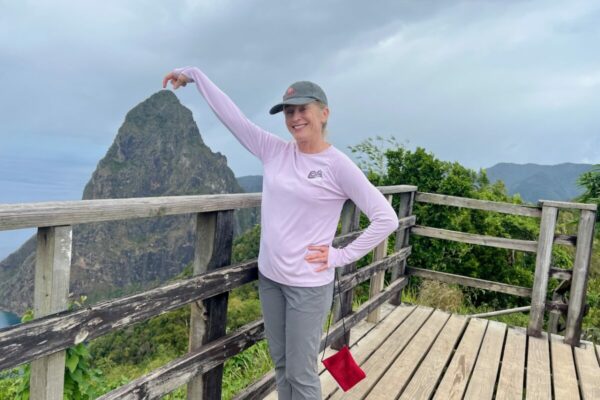

If you’re planning to visit Ljubljana, Slovenia, you’ve come to the right place for a totally honest guide to Europe’s most charming capital city. Read on to find out what to see, where to stay, what to eat and what NOT to do in Ljubljana.
I’m an American journalist who first came here in 2009 to embrace my Slovenian roots. You might have seen my family on HGTV House Hunters International. We fell in love with the historic, car-free city center of Ljubljana. And we want visitors to enjoy it as much as we do. How to pronounce it: Lyoo-blee-yah-nah.
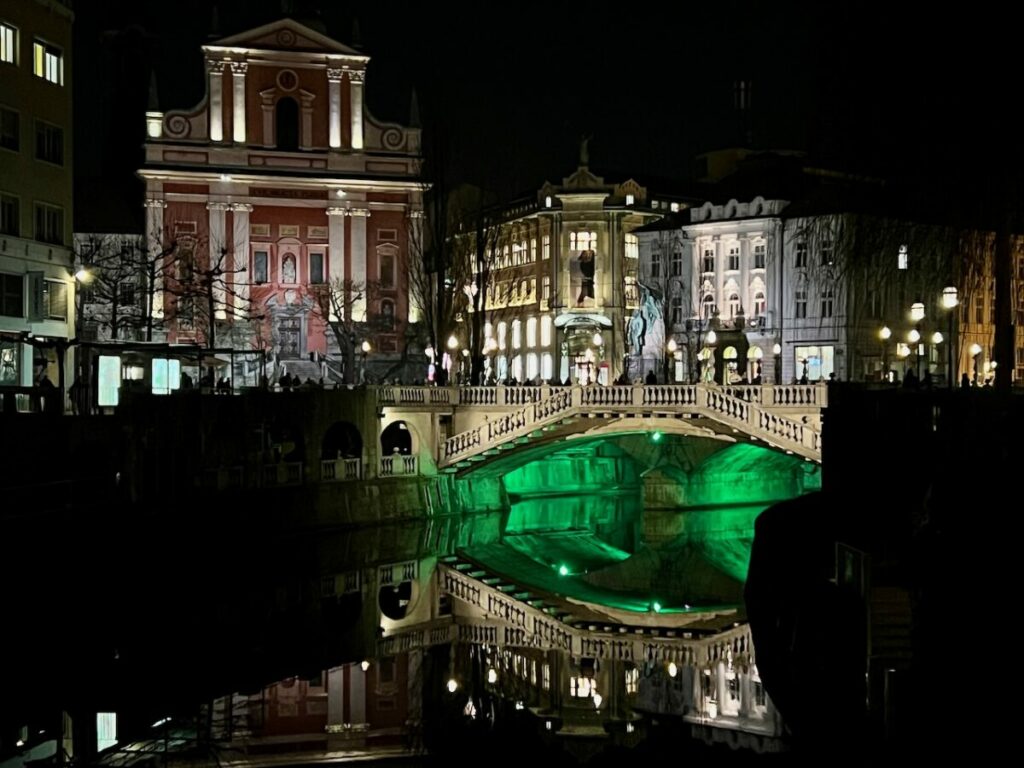
No matter how many times I see this view, it takes my breath away. Ljubljana’s car-free center at night, with the Triple Bridge, pink church and Prešeren statue.
How and When to Visit Ljubljana, Slovenia
Click on this link to read my top tips for planning a trip to Slovenia: flights, bus and train travel to Ljubljana, airport transfers and rental cars. Also, what documents you need, money and tipping, what to pack and when to visit. Bottom line:
- Go Opti is the most efficient airport transfer. Use this link to book your first Go Opti with a discount.
- You can take a bus, train or drive a rental car from the neighboring countries of Italy, Austria, Croatia or Hungary.
- Car not needed for Ljubljana and some day trips. Better to have a car in the rest of Slovenia.
- Ljubljana is enjoyable all year long and might even have Europe’s best Christmas market.
- Honest tip: August is the most crowded month, when most locals leave town. Reserve your hotel well in advance and be patient with slow service.
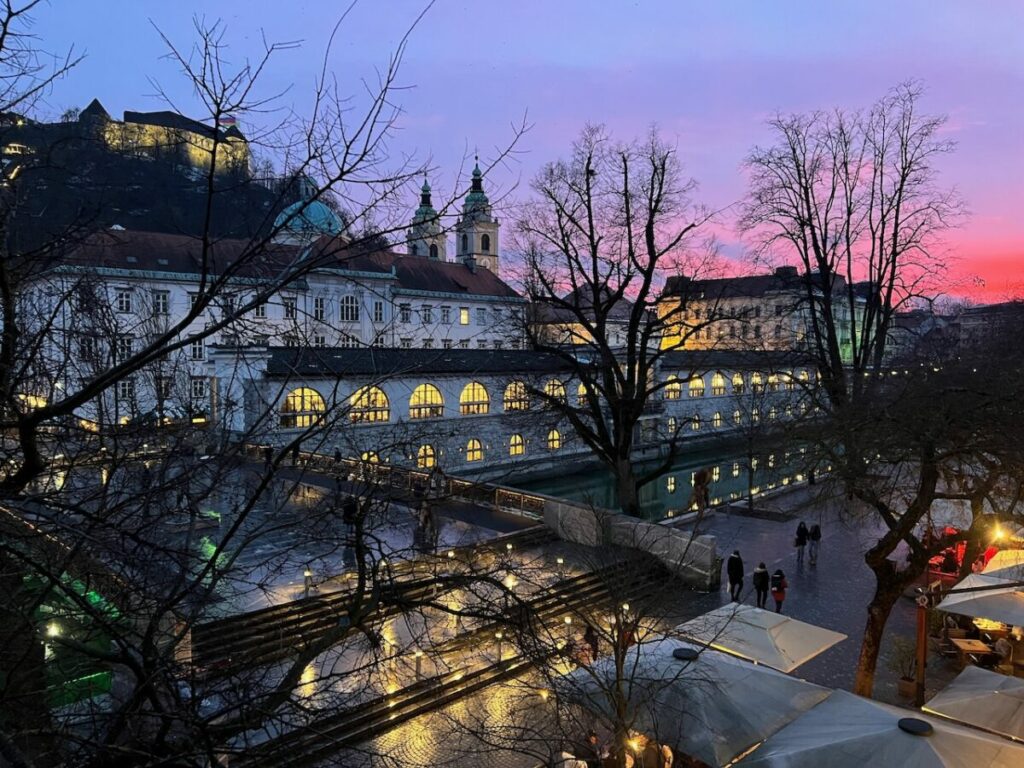
A breathtaking sunset at the covered Roman Marketplace, part of the Plečnik architecture UNESCO heritage in Ljubljana, Slovenia. You do not need or want a car to enjoy the beauty of the city center, where there is NO free parking. All the main sights are within walking distance.
How much time do I need to visit Ljubljana?
You can see the highlights of Ljubljana’s walkable, car-free center in one or two days. But there are plenty of reasons to stay longer.
What to Pack: Must have: sturdy walking shoes for city streets and mountain paths. Be prepared to dress in layers for very changeable weather.
To save time: Take the free walking tour of Ljubljana offered daily, starting from outside the pink church in Prešeren Square. Or sign up for a custom tour with a local guide. Tours are also available through the Visit Ljubljana office at the Triple Bridge.
To save money: Buy the Visit Ljubljana card online or at the tourism office. It includes a walking tour, riverboat ride, funicular to the castle, public transportation and bike rentals, plus admission to many top attractions.
Honest tip: Armed with a free map from the tourism office or your hotel, it’s not hard to do a walking tour of Ljubljana’s highlights on your own. Flag down a bright green “kavalir” golf cart if you get tired and need a free ride within the car-free center.
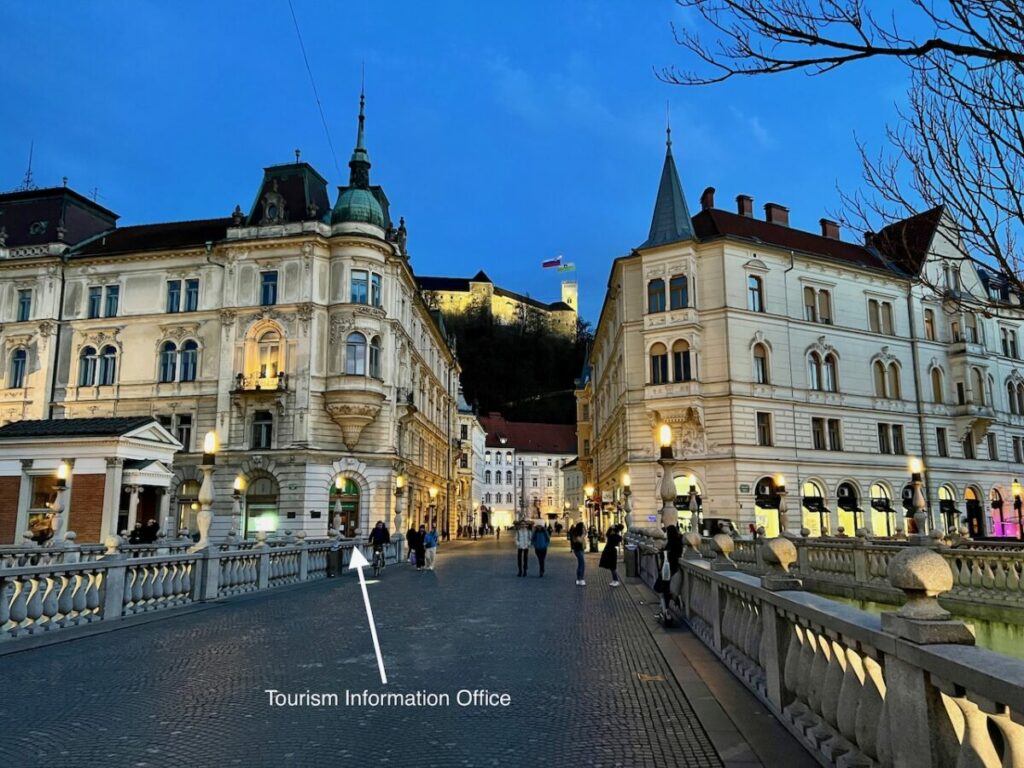
As you cross the Triple Bridge, plan to stop in the Visit Ljubljana tourist information office to get a free map, sign up for a tour, or save money with the Visit Ljubljana card. Open from 8 am to 6 pm Monday through Saturday, closes at 3 pm Sundays and holidays.
What are the Top 10 Things to See and Do in Ljubljana?
- Prešeren Square
- UNESCO architecture of Jože Plečnik
- Ljubljana Castle Hill
- The Medieval “Old Town”
- Dragon Bridge
- Trubarjeva Street
- Art Nouveau in the “New Town”
- Socialist Modernism in Trg Republike
- Culture break: museums, opera and ballet
- Enjoy nature in Tivoli Park and Špica beach.
Prešeren Square: Central Meeting Point in Ljubljana, Slovenia
Prešeren Square is the starting point for many Ljubljana tours and local meetups. You’ll notice people gathering around the statue of the poet France Prešeren or in front of the pink church. There’s usually a guy playing Slovenian accordion music, but if you want to take his picture he’ll expect you to drop a few coins in his case.
Prešeren (pronounced Presh-air-en) lived from 1800 to 1849, a time when the local language was frowned upon as lowly peasant talk. Writing poetry in Slovene made him a national hero. But it didn’t help him win the girl of his dreams. His statue is doomed to forever gaze across the square at the terracotta likeness of Julija, which you can find on the wall of a storefront at the entrance to Wolfova Street.
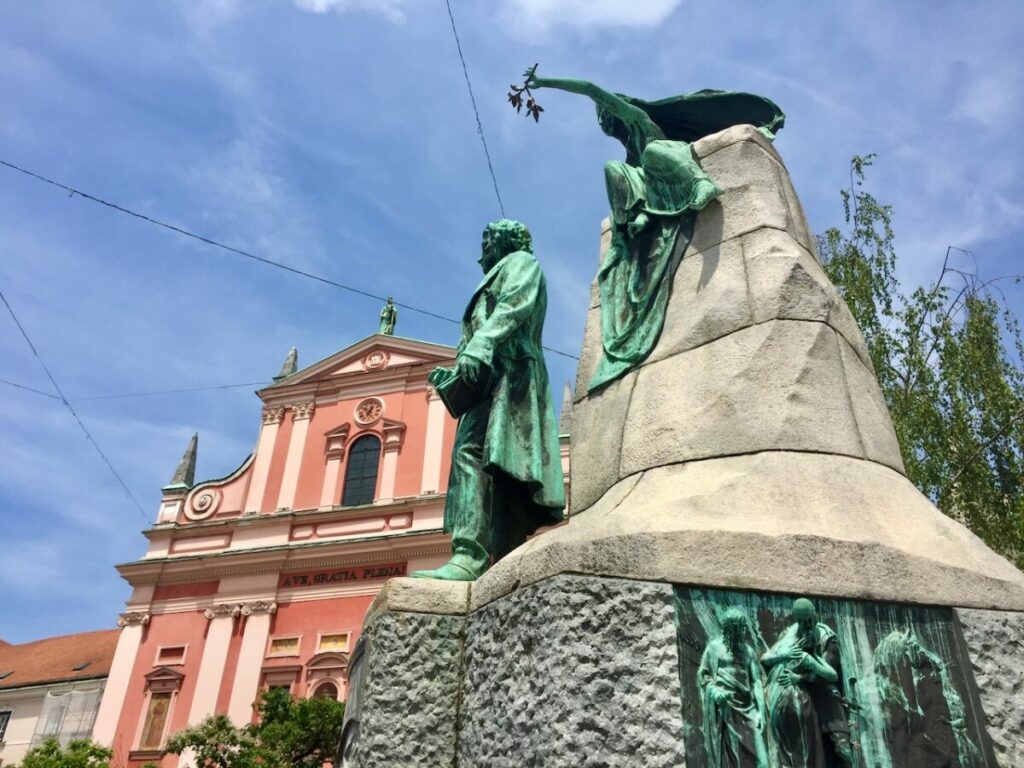
The topless muse holding the branch above the poet’s head caused a scandal at the pink Church of the Assumption. A conservative pastor insisted on planting trees to prevent the faithful from fixating on bare breasts as they were leaving Holy Mass. The words to Slovenia’s national anthem are from Prešeren’s poem, “A Toast.”
The church itself dates back to the 1600s. Its interior is well worth a visit and displays an elaborate nativity scene during the December holidays. The rest of the buildings on the square were built after the 1895 earthquake that devastated the city. The Galerija Emporium is a pretty example of Parisian-influenced art nouveau, filled with the city’s priciest designer brands. There’s a lot more art nouveau to see, but more on that later.
UNESCO World Heritage Architecture of Jože Plečnik
You’re now ready to cross the Triple Bridge, designed by Jože Plečnik (pronounced Plech-neek). His influence on Ljubljana is often compared to that of Gaudi in Barcelona. Watch the video to learn more about his life and work. (And please subscribe to the Terry Anzur YouTube channel for more trip videos in Slovenia.)
Triple Bridge: Asked to replace a narrow bridge, Plečnik kept the old one for two-way traffic while adding the distinctive pillars and two pedestrian lanes on either side in 1929. It blends perfectly with the embankments he designed to prevent flooding along the Ljubljanica River. It was possible to drive your car on the bridge until 2007 when it became part of the car-free zone.
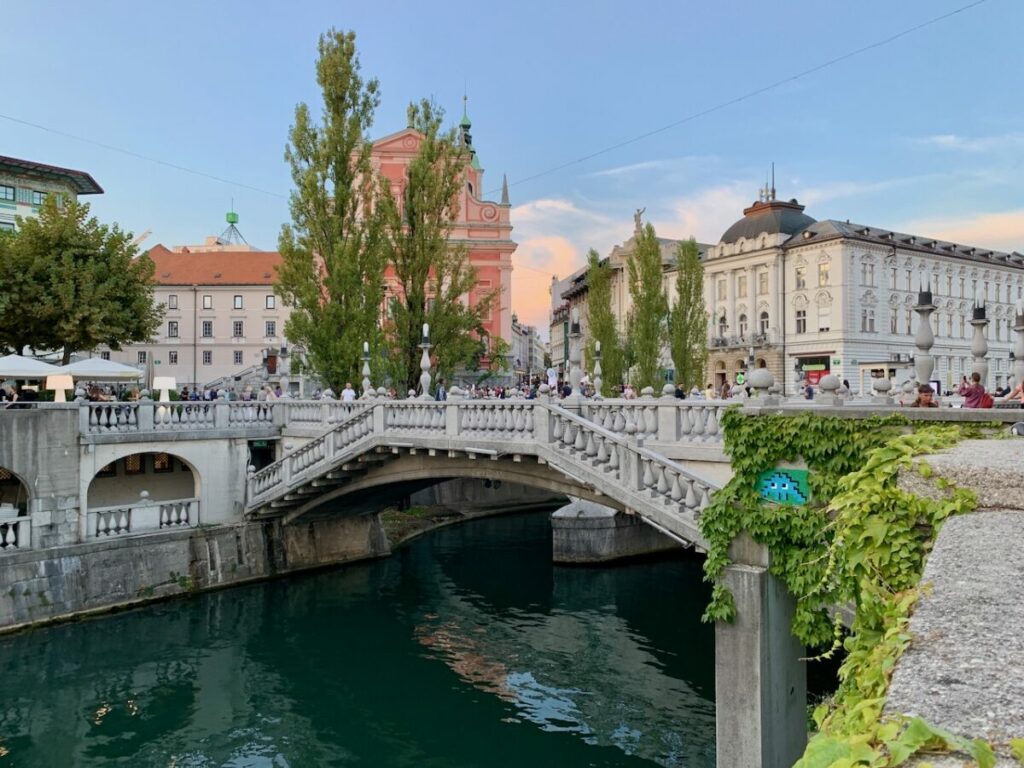
The Triple Bridge leads to Prešeren Square, the central meeting point for both tourists and locals in Ljubljana. It connects to the Old Town on the opposite end at the foot of Ljubljana Castle.
Covered Roman Marketplace: As you cross the Triple Bridge toward the Castle Hill, Plečnik’s covered Roman Marketplace stretches out along the river to your left. The fish market is on the lower level, along with public restrooms. Keep walking along the colonnade to pass by casual eateries, the locks of love on Butchers Bridge near the meat markets, and explore the stalls in the open-air Farmers Market.
Totally Honest tip: I’m a bit intimidated by the outdoor market and the Pokrita Tržnica (secret market) in an adjacent building for the meats, cheeses and other refrigerated goods. I don’t shop there unless I’m with someone who speaks fluent Slovenian. There may or may not be different prices for locals and tourists, depending who you ask. I DO use the Mlekomat, a 24-hour vending machine for fresh unpasteurized milk from local cows when I run out of milk on Sundays or holidays. That’s when all of the grocery stores in the entire country (and the outdoor market) are closed.
National Library: Consult your map for the 10 minute walk from the Triple Bridge in the opposite direction along the river, hard right at the Novi Trg fountain to the Narodna Univerzitetna Knijznica. Small wonder that locals simply call it the NUK (newk). Notice the windows, shaped like open books. Buy a ticket to see the grand staircase and reading room inside this temple of knowledge. However, students say the statue of Moses outside is pointing the way to a local bar.
Križanke: Nearby is the Križanke monastery, which Plecnik renovated as a concert venue and high school. Fun Fact: a young Melania Trump was once among the design students at Križanke before she left to pursue a modeling career.
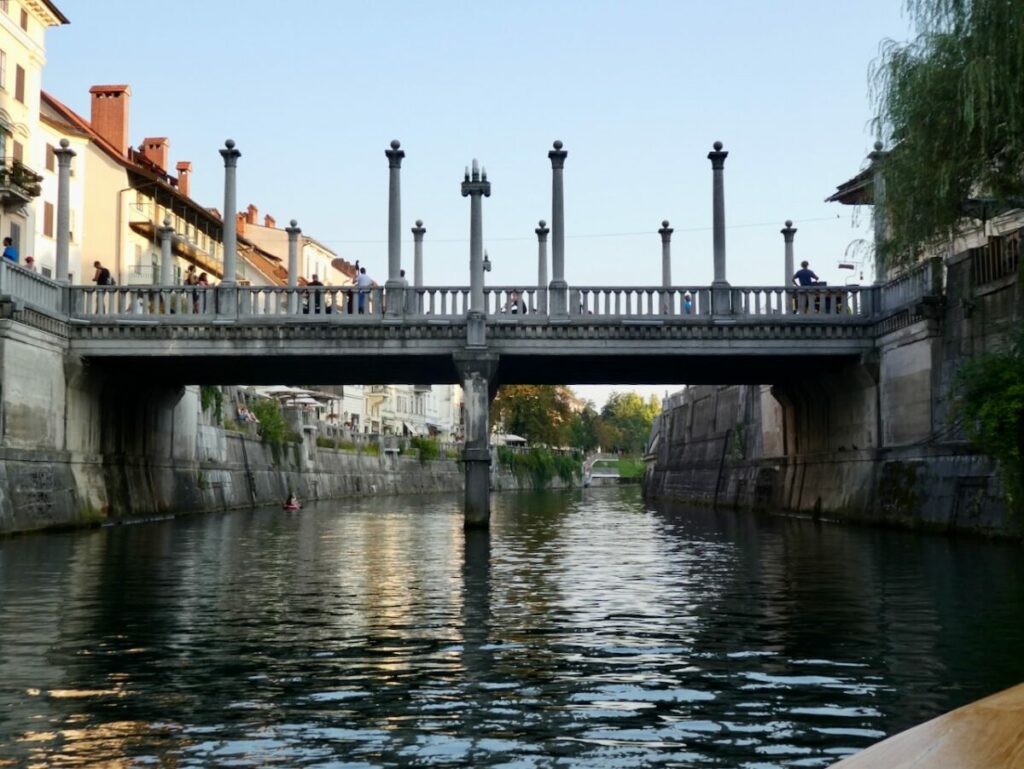
Totally honest tip: Allow about 45 minutes to take a riverboat ride, a relaxing way to get off your feet for a while and admire the designs of Joże Plečnik from the water. It’s included with the Visit Ljubljana Card, or just buy a ticket at one of the boat kiosks (14 euros last time I checked, 7 euros for kids) and hop on. All the boats offer pretty much the same tour. This is the Cobbler’s Bridge, designed by (who else?) Plečnik. There are no longer any shoe-making shops nearby.
If you have more time, make a reservation for a tour of Plečnik House in the historic Trnovo neighborhood. It’s an easy walk from the NUK and Krizanke.
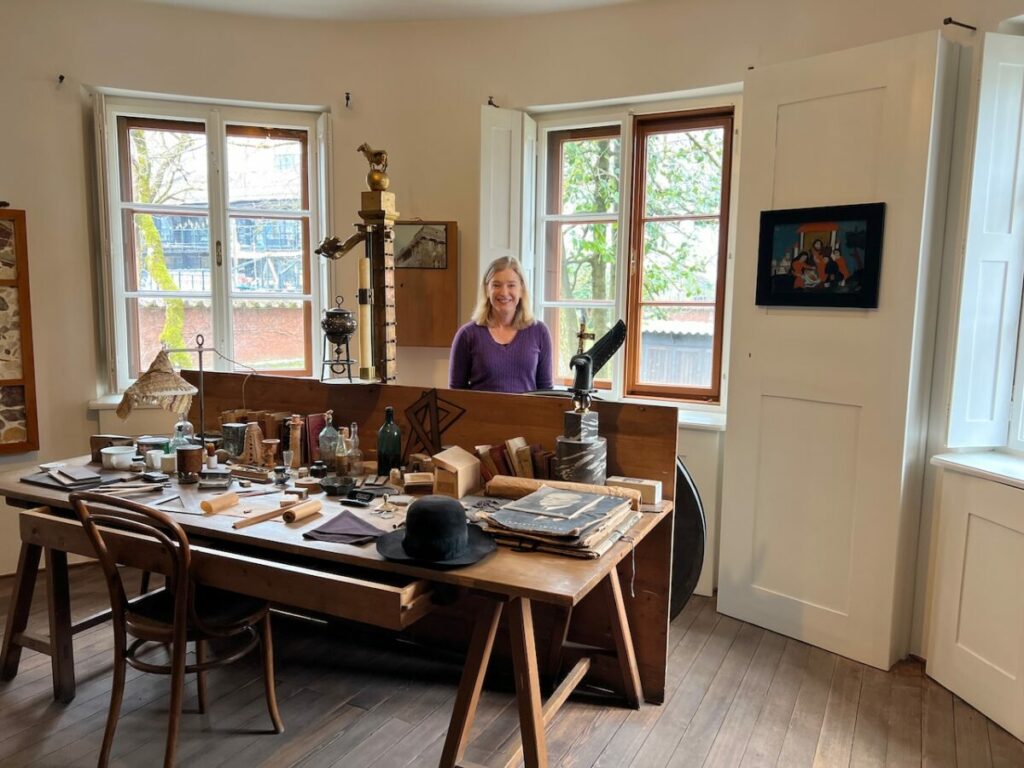
On a tour of Plečnik’s House, you’ll take a deeper dive into the mind of a genius architect. He was a workaholic who slept only steps away from his drawing table and preferred the company of his dog to people. The house has been preserved as it was when he died in 1957. You should make a reservation if you are interested in this tour, a good value for 8 euros last time I checked. Some interesting exhibits are open to the public free of charge.
Stroll Around Ljubljana’s Old Town
I lovingly refer to this side of the river as Slavic Disneyland. But it’s totally for real, with parts of the much-renovated buildings dating back to medieval times. Inside the city hall you can check out the cool baroque courtyard and free cultural exhibits. As you face city hall, you’ll see the Robba Fountain to the left. It looks like something that got lost on its way to a piazza in Rome, but it’s only a replica. The original is in the lobby of the National Gallery.
Continue past the fountain to reach St. Nicholas Cathedral. There’s an admission charge to see the Austrian baroque interior. It is closed to tourists during Sunday Mass. Worshippers are welcome to attend the entire 45-minute service (in Slovene) free of charge. But if you do anything touristy like taking pictures, an usher will firmly show you out. Don’t miss the two ornate exterior doors, depicting the religious history of Slovenia and its bishops.
Besides the restaurants and cafes, the street between Mestni Trg (City Square) and Stari Trg (Old Square) has artisan shops for sea salt, honey, Rogaška Crystal and other Slovenian products. At the far end is Gornji Trg (Mountain Square), where you can connect with one of the paths up to the castle.
Climb the Hill to Ljubljana Castle
The funicular ride to Ljubljana Castle is included with your Visit Ljubljana card, or you can buy a ticket at the base station, not far from the Farmers’ Market and next to the Puppet Theater. If you happen to be there on the hour between 8 am and 10 pm, you’ll hear a catchy tune as statues of folk hero Martin Krpan and his faithful mare Kobilica emerge from the theater’s clock. Have your camera ready for a spectacular view as you ride up to the castle in the clear gondola. It’s definitely worth doing, especially if it’s your first visit to Ljubljana or you don’t have the time/energy to climb the hill on your own.
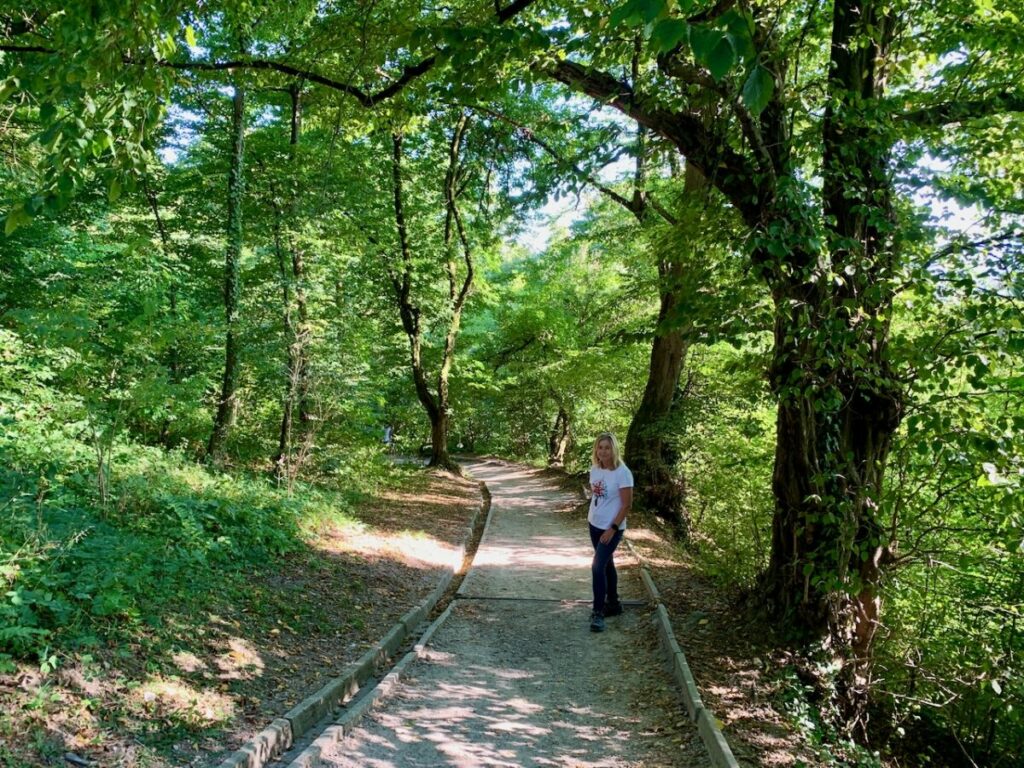
Totally honest tip: To local residents, the gondola to Ljubljana Castle is just a tourist attraction. The famously thrifty Slovenes see no reason to pay if they can walk up to the castle for free. The paths and steps are very steep. But some of my neighbors and their sturdy dogs do this climb almost every day, depending on the weather. This path starts near Farmers’ Market in Vodnikov Square, on the side nearest the castle. Allow 20 minutes each way, plus time to explore the castle at the top.
Ljubljana tries hard to weave a story of princes and dragons around the castle. The truth is that it was a strategic military position that has served as a prison or public housing at various points in its history. You’ll have to Visit Celje to see the hometown of the ruthless counts who married their way into most of Europe’s royal families. And left their three stars on Slovenia’s flag.
Today, Ljubljana’s mighty fortress is truly the people’s castle with something for everyone, even outdoor movies in the summer. Besides the Michelin-guide restaurants and a jazz club, there’s an affordable cafe in the courtyard. Some exhibits require an admission ticket. But you can prowl some of the turrets and passageways free of charge. Or join the Instagrammers jostling for selfies at a free observation deck overlooking the city with the snow-kissed Alps in the distance. As you stroll around the castle grounds, you’ll see a cutting from the world’s oldest grapevine in Maribor, a working vineyard, a Plečnik walkway and a single monument to the long history of Slovenian peasant uprisings.
Strike a Pose at Ljubljana’s Dragon Bridge
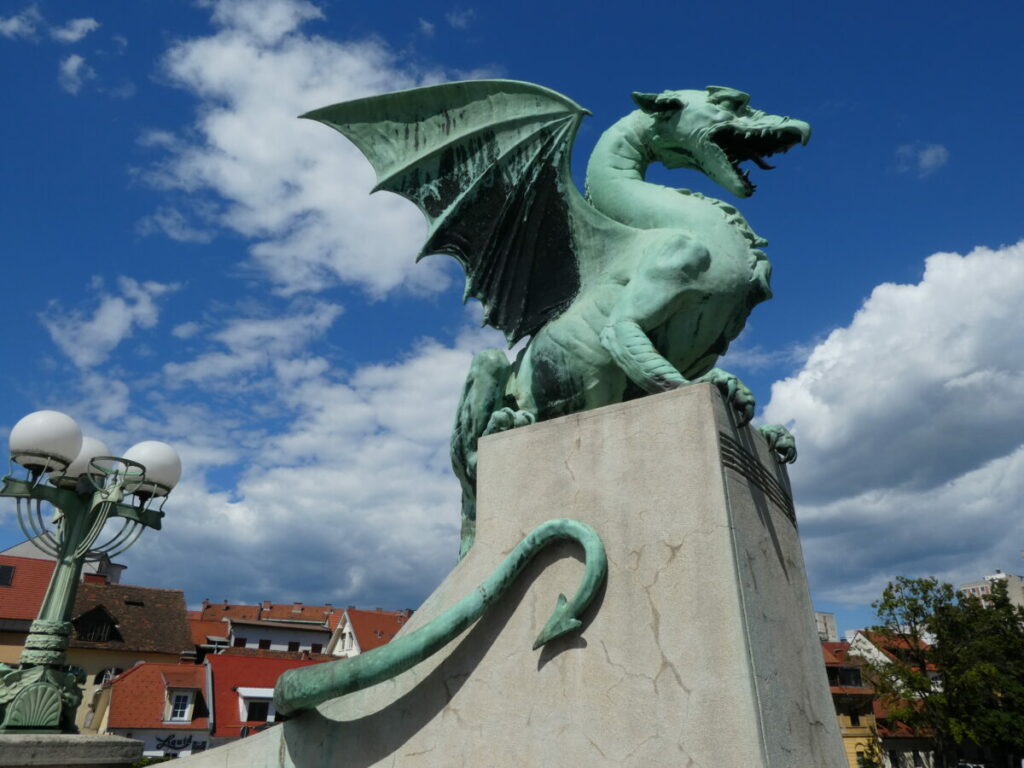
When you reach the end of the market colonnade, you’ll find the Dragon Bridge (Zmajski Most). Not designed by Plečnik, these four dragons are one of my favorite things in Ljubljana. I walk by them nearly every day. I swear their snarky expressions change depending on the weather. Legend has it that they wag their tails if a virgin walks by. It’s surprisingly difficult to get a decent selfie with them on their lofty pedestals, but that doesn’t stop tourists from trying every angle (and nearly being run over by traffic).
Trendy Trubarjeva Street
One short block from the Dragon Bridge, you’ll find the coolest street in Ljubljana: Trubarjeva Cesta, named for the cleric who published the first book in the Slovenian language. Trubarjeva starts out fancy at Preseren Square and parallels the river. It gets funkier after it passes the Dragon Bridge. It eventually reaches the former Rog bicycle factory, now being renovated as a creative high-tech center and park. Trubarjeva is lined with a variety of ethnic eateries from Middle Eastern falafel to Korean street food and Balkan favorites like čevapi and burek. If you’re on a budget, this street is a good bet for a tasty, affordable meal.
Totally Honest tip: Ljubljana gets its youthful energy from the fact that the city is a giant student dorm during the school year. Many Slovenian towns aren’t big enough to support specialized high schools or colleges, so people send their kids to board and study in the capital. The students get subsidized coupons to buy food at any restaurant or takeout with the sign “studentski boni” in the window. This system not only feeds the hungry students — it encourages good food at reasonable prices for you, the paying customer.
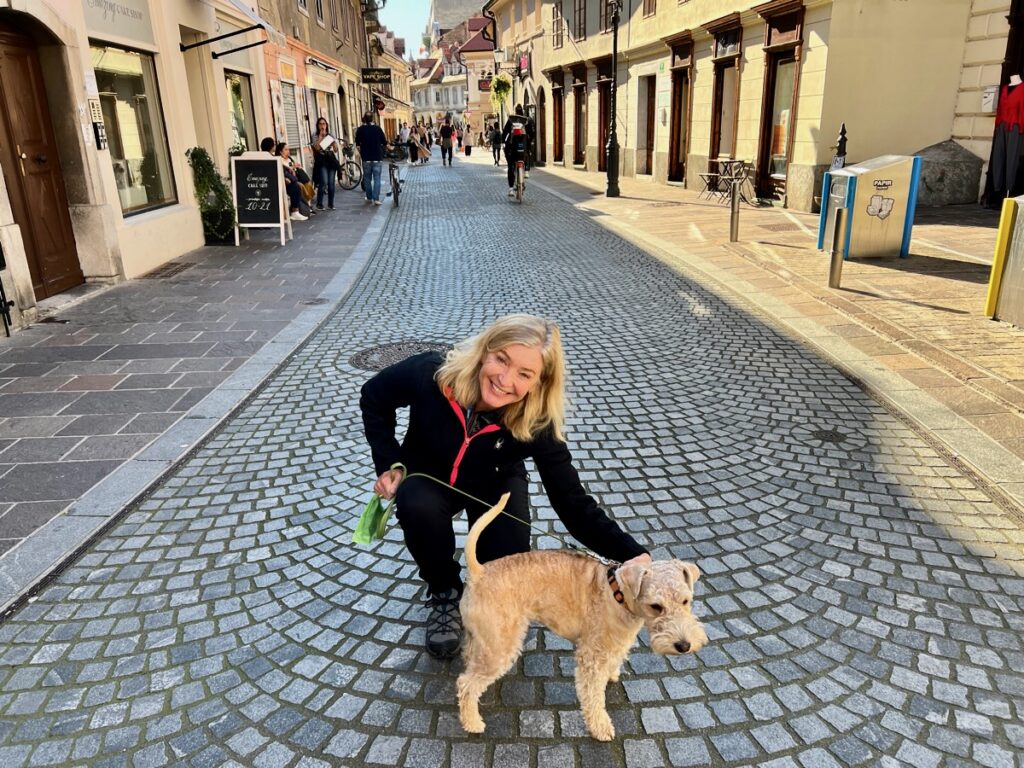
Walking my neighbor’s dog, Orf, on Trubarjeva Cesta. It’s the coolest street in Ljubljana, where visitors can feel the youthful energy of students and mingle with neighborhood residents. It’s lined with quirky shops and affordable eats.
Art Nouveau in the “New Town”
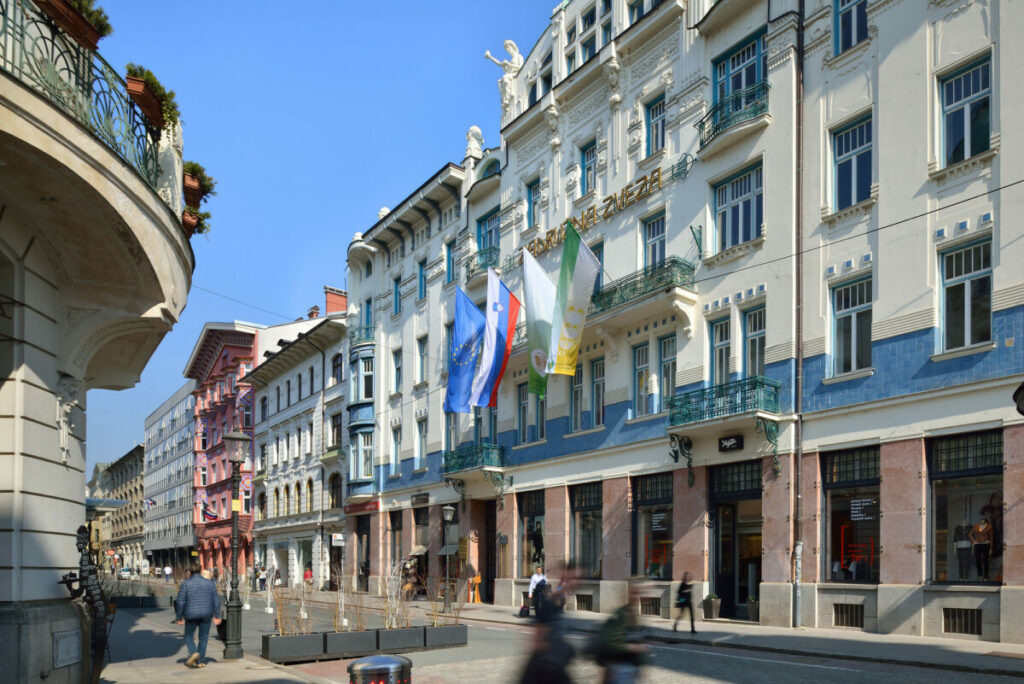
Buildings on the “New Town” side of the river reflect the Art Nouveau or Viennese Secession style of architecture. It was all the rage in the years following the 1895 earthquake that destroyed Ljubljana. This row of beauties is across from the Grand Union Hotel. Photo credit www.slovenia.info, Miran Kambic.
Trg Republike and Socialist Modernism
National Assembly and Trg Republike Square: From Congress Square, cross the main business street, Slovenska Cesta. It marks the edge of the pedestrian zone. Beyond, you will find the distinctive Parliament building, decorated only with statues of naked men, women and children. This huge square is where Slovenia declared its independence in 1991. But the socialist modernist architecture reflects Yugoslavia’s relatively prosperous times in the 1960s and 70s. If you’re curious about life in Slovenia under Josip Broz Tito, take the Ljubljana Communist Tour or visit the Museum of Contemporary History in Tivoli Park.
Recommended Reading: For a fun action-adventure story, download Tito’s Lost Children: A Tale of the Yugoslav Wars. Fictional characters get caught up in the REAL events that led to the breakup of Yugoslavia, Slovenia’s independence and the Balkan Wars. Book One: Slovenia is a FREE ebook download on Amazon, read on any device with the free kindle app. Or order a paperback.
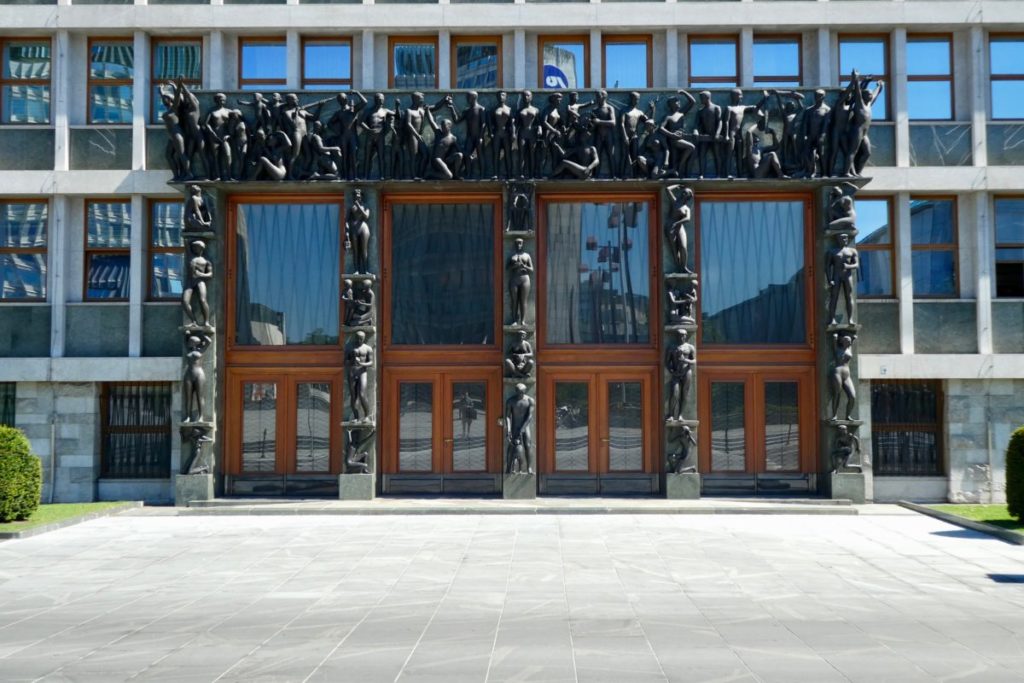
The copper statues of naked men, women and children are the only decoration on Slovenia’s National Assembly building. The interior is open for tours once a month, by reservation only.
Opera, Ballet and Museums in Ljubljana, Slovenia
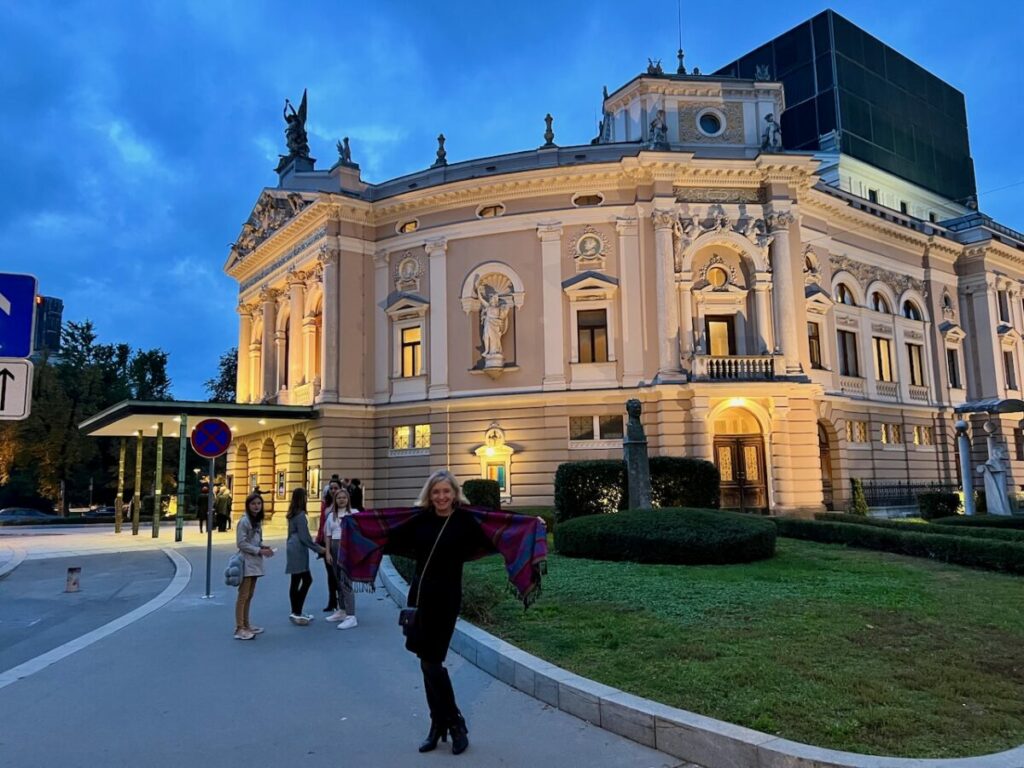
Slovenian National Opera and Ballet: My very favorite evening activity in Slovenia is surprisingly affordable! World class opera (usually with English subtitles) and ballet at a fraction of what you’d pay in Vienna, Milan, the UK or US. Check the program and buy tickets online, or at the box office. The theater itself is a gem from the Austrian times. Also check what’s on at Cankarjev Dom, a more modern theater with a bigger stage. Open-air performances are in Congress Square or Križanke, depending on the time of year. Plays at the National Drama Theater are not really an option unless you speak Slovene.
Museums: You would need a week to visit all of Ljubljana’s Museums. Most of them are free on the first Sunday of every month. Highlights:
- City Museum, near Križanke, with perhaps the world’s oldest wheel and much more.
- National Museum near Republik Square, with the world’s oldest musical instrument and other artifacts from the prehistoric and Roman times.
- Slovenian Ethnographic Museum (the SEM), near Metelkova, with rotating cultural exhibits about life in Slovenia like a store designed by Plečnik, or crazy costumes from Pust, (Slovenia’s carnival).
- National Gallery: If you love the impressionists, discover a few new favorites among the Slovenian painters.
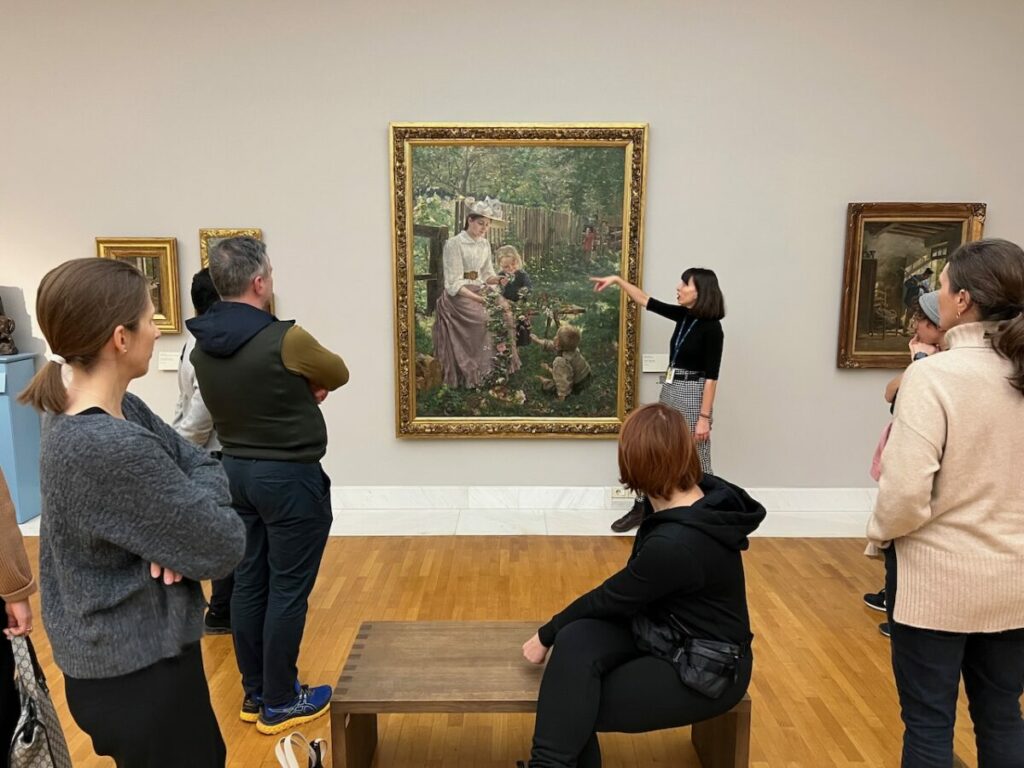
Visitors to the National Gallery admire a painting called Summer by Ivana Kobilca, a remarkable woman among the Slovenian impressionists.
Alternative Ljubljana: Metelkova is a pocket of counter-culture in a cluster of former military buildings. One of them is a hostel with artsy rooms in a former prison.
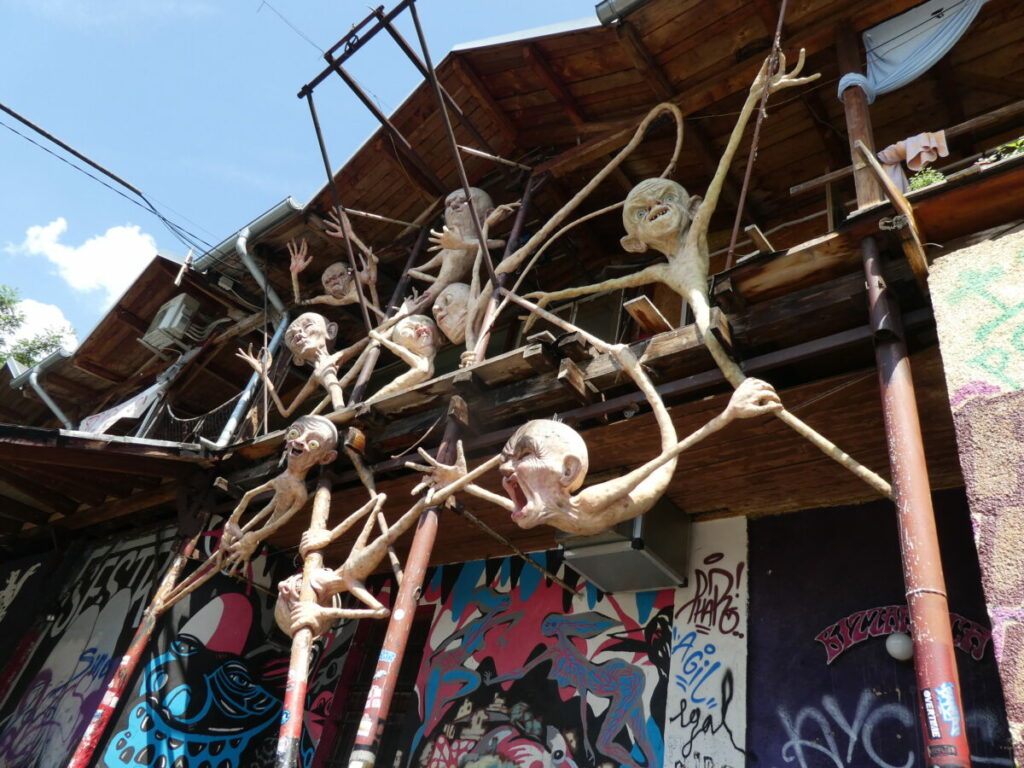
There’s plenty of street art to admire in Metelkova. But the center for “alternative” Ljubljana is actually rather dead during the day and people really don’t want you to take their picture. The after-hours alternative party scene here doesn’t really get going until after 10 pm or even midnight.
Enjoy “Nature” in the City of Ljubljana
Steps away from the National Gallery is Tivoli, the Central Park of Ljubljana. Explore by bike, or walk up the hill on the popular path to Rożnik. The hilltop has a cute (but closed) 16th century pink church and busy cafe. Try the flancat pastry if you’re up for a snack.
Another walk or biking destination is Špica, a man-made “beach” that was created where a canal branches off from the Ljubljanica River. You might encounter the nutria, begging for scraps of fruit and vegetables despite the signs urging people not to feed them. These river rats were imported from South America for their fur and released into the wild when fur fell out of fashion. My son, an author who lives in Ljubljana, even wrote a novel about the nutria, similar to Watership Down, but with talking river rats instead of rabbits.
Totally Honest Tip: You can rent a canoe or SUP to explore the river, but you’ll have to dodge the tour boats. You don’t want to go for a swim. Although it’s cleaner in recent years, the water flows through farmland on its way to the city, picking up agricultural waste and chemicals.
Where to Stay in LJubljana, Slovenia
I highly recommend staying in or near the car-free zone and walking everywhere. There’s a wide choice of hotels and hostels for every budget. Some mid-priced choices are the City Hotel with a bountiful breakfast buffet or the eco-friendly Hotel Park. At the luxe end is the high-rise Intercontinental. Boutique hotels right next to the riverwalk include the Vander Urbani, the Hotel Heritage or the Zlata Ladjica (Golden Boat). The Grand Union and the Hotel Slon are reliable choices in great locations. Thanks in advance for clicking on any of these links to see all the choices on Trip Advisor and make a reservation. It supports this blog at no cost to you.
What to Eat in Ljubljana, Slovenia
The food scene in Ljubljana is constantly changing. Places that are a good value or a ripoff get a reputation quickly in this small, gossipy city. There’s everything from international street food to fine dining with famous TV chefs. The latest trendy spot might require a reservation. Meat rules, but there’s a growing number of vegetarian and even vegan options.
On Fridays from April to October, people chow down at the Open Kitchen food festival between the covered marketplace and the cathedral in Pogačar Square. It’s fun to browse the food stalls for the most famous dishes from lots of popular eateries, but good luck finding a place to sit down.
Totally honest tip: Depending on your price range, it’s hard to go wrong at any of the busy indoor-outdoor restaurants in Old Town or along the river. But you’ll notice that most of the people ordering food there are visitors or celebrating a special occasion. The thrifty Slovenes tend to relax by the river with only their drinks, small snacks or desserts; they head away from the beaten tourist path if they’re going to order a full meal.
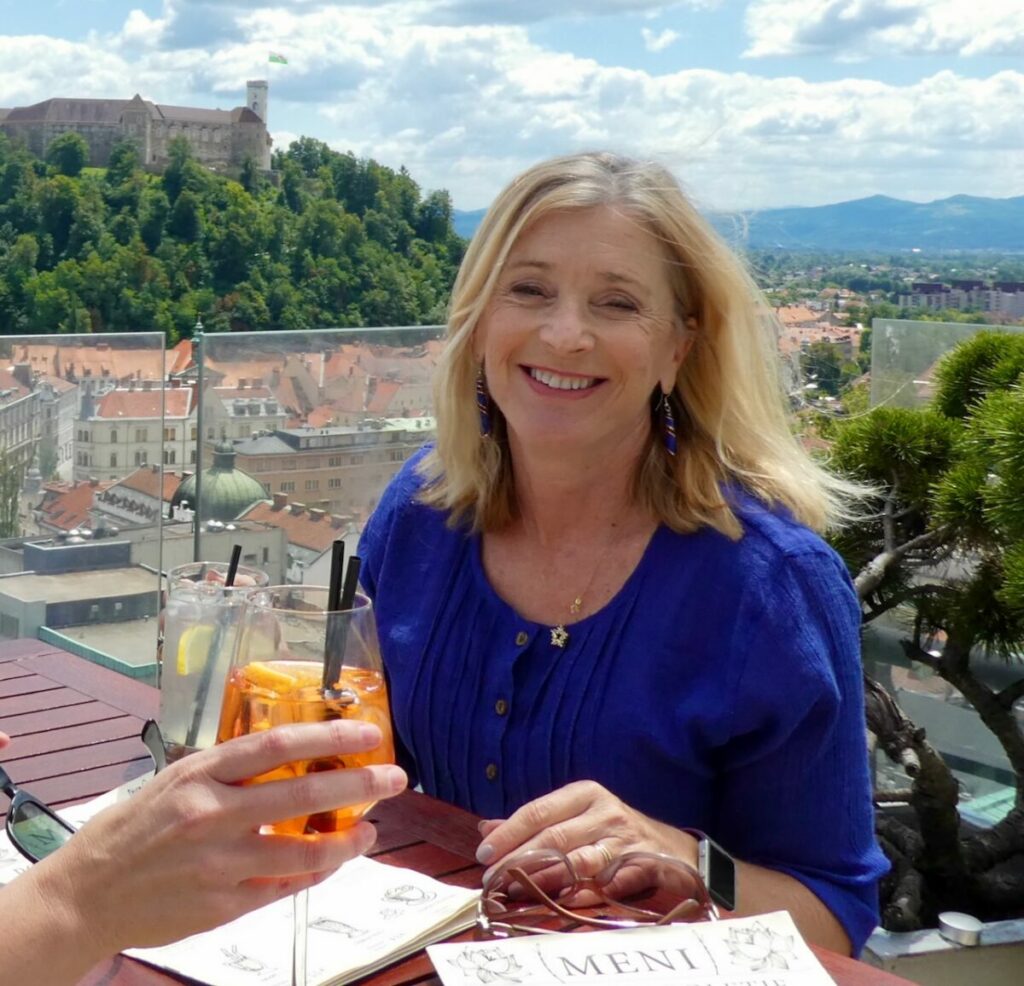
Best choice for a drink with a view of Ljubljana is the Nebotičnik. This “skyscraper” was the tallest building in the Balkans when it was built in 1933. Their “naravna limonada” (natural lemonade) is famous. Enjoy the quirky elevator and the circular stairways inside. The entrance is just off the main business street, Slovenska Cesta.
Traditional Slovenian Food and MORE
A typical lunch usually includes beef or mushroom soup, a main course and dessert. My local tour guide friends swear by Sokol in the Old Town, but my neighbors prefer Gostilna Šeštica, the oldest restaurant in Ljubljana. A gostilna is a full-service, sit-down place like you might find at a country inn. Restavracije tend to be fancier. Less formal places might advertise a malica, a fixed-price multi-course meal served in the middle of Slovenia’s 8am to 4pm workday.
If your hotel doesn’t offer breakfast, try the Cafe Capri near the Dragon Bridge, Kavarna Rog in the old bicycle factory or Le Petit Cafe on Trg Francoske Revolucije (near Križanke).
Other typical Slovene delights: Kranjska klobasa sausage at Klobasarna in Old Town. Moji Štruklji in the covered marketplace for rolled dumplings with various sweet or savory fillings. To be honest, most Slovenes think the best place for traditional food is at their grandma’s house. Check out my friend Špela’s Cook Eat Slovenia cookbook for a complete, beautifully illustrated guide to Slovenian cuisine in English.
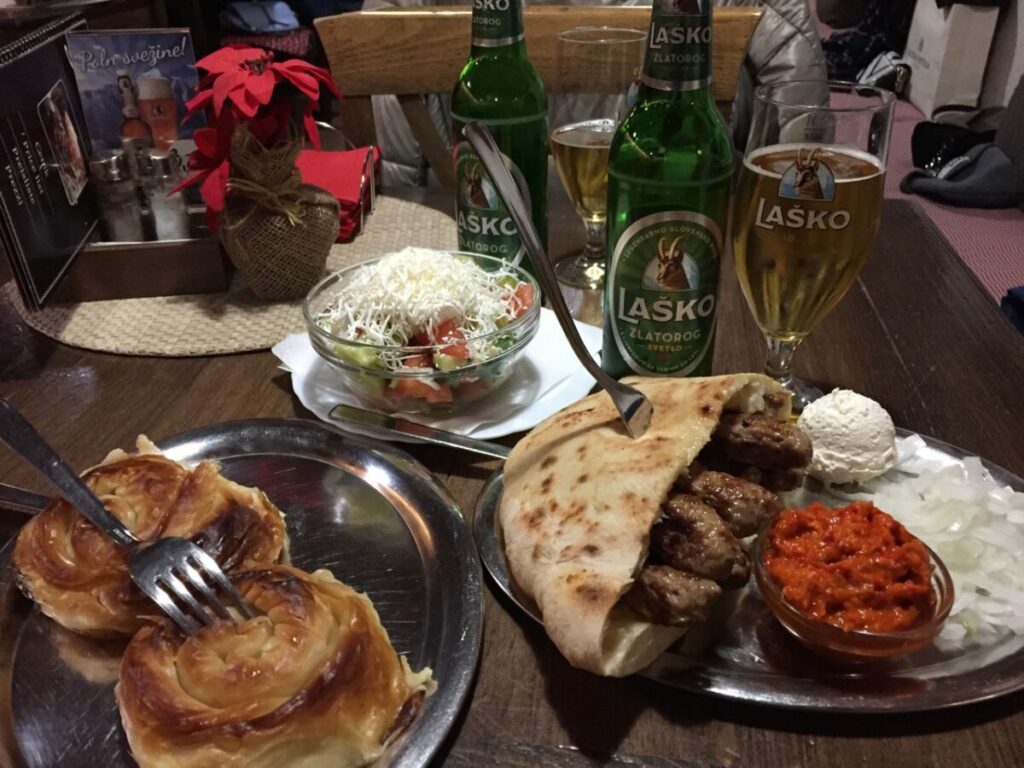
Totally honest tip: Slovenians will be quick to tell you it isn’t the true “Slovenian food,” but they love the traditional tastes of the Balkans. In this picture: burek (pite), šopska solata, and čevapi with Slovenia’s Laško beer.
Balkan Food: This is the comfort food of the former Yugoslavia. Sarajevo 84, Saraj,and Das Ist Walter are places to try čevapčiči, grilled ground beef or pork sausages. Order a “desetka” of 10 or a “petka” of 5, with spicy orange ajvar sauce or buttery kajmak on the side. I don’t eat meat but enjoy the pastries called burek or pite with spinach or cheese filling. And šopska solata, a tomato/veggie mix with grated “young cheese” on top. For the fast-food budget-friendly version, open 24 hours, there’s a rivalry between Burek Olimpija on Slovenska Cesta and Nobel Burek on Miklošečeva Cesta so try both and decide.
Ice Cream: Influenced by the gelato in neighboring Italy, the sladoled in Ljubljana is an ice-cream lover’s dream. Again, you can’t go wrong. Cacao by the river and Vigo near city hall are two of the most popular.
Pizza and Burgers: Pizza lovers rave about Pop’s Place on Novi Trg, but I prefer the Italian ristopizza at Capriccio in the Old Town. Osmica, on a side street near the Hotel Slon, is popular with students — a good sign. Dvor, on the riverfront, has huge but thin New York-style pizzas. Ljubljana generally does burgers well; they’re similar to a Balkan dish called pljeskavica. And yes, there are at least four very busy McDonalds in Ljubljana. Other fast food chains have a hard time competing here.
What to Drink in Ljubljana, Slovenia
Coffee Culture: Each kavarna in Ljubljana has put its own spin on Viennese coffee culture, advertising which brand of beans is served. Barcaffe is the tasty coffee from Yugoslavia times. But Slovenians are quite snobbish about preferring the major Italian brands, or local artisan roasters like Crno Zrno in Gornji Trg or STOW in the City Museum near Križanke with a takeout in Prešeren Square. Try the cafe at the Grand Union Hotel for the old Vienna ambience, or sip with the beautiful people in the cafe at the Hotel Slon. It’s always time for coffee (or tea) in Ljubljana, with a decadent pastry on the side.
Mineral Water: Radenska, the most famous local mineralna voda in Slovenia, is served everywhere. Ljubljana is also quite proud of its tap water (voda iz pipe). It is served for free even in the fanciest restaurants, and always with your cup of coffee or glass of wine. Disposable plastic water bottles are frowned upon. Bring your refillable container to any of the public taps throughout the city.
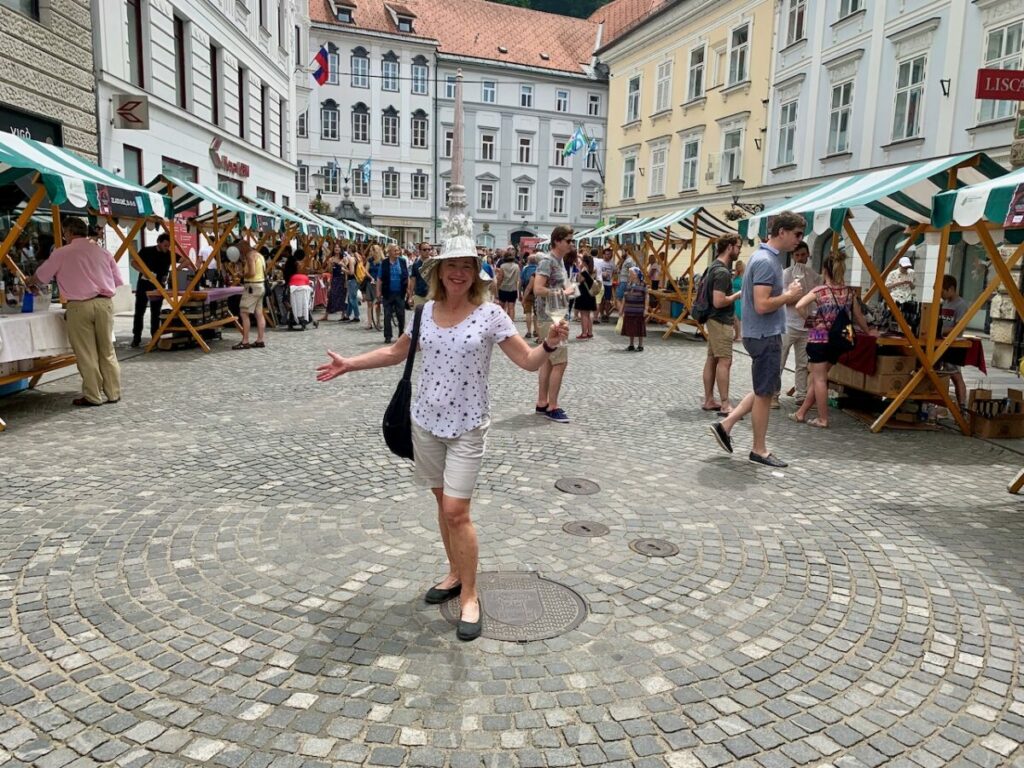
The Ljubljana wine road festival, held twice a year in June and November, is a chance to sample wines from all over Slovenia in a souvenir glass.
Local Beer: You can take the very corporate tour at the Union brewery but I recommend you just try the local beer anywhere. Except the places that serve the competing brand from the town of Laško. Heineken now owns both brands, but that hasn’t stopped the raging local argument over which is better. Lots of craft beer to try at Pivnica Lajbah just outside the pedestrian zone on the river.
Wine Tasting: Slovenians export very little of their delicious wine. They drink almost all of it themselves. Malvasija and rebula are the whites, refošk and teran are the reds that originate here. Wine tasting in Ljubljana has so many great options that I wrote an entire post about it. Be sure to try the “orange” wine and make up your own mind on cviček (svee-check). That’s a low-alcohol mix of red and white. Or book a fun evening of Slovenian wine tasting in the cellar under Dvorni Bar that dates back to the Roman times.
What NOT to do in Ljubljana, Slovenia
Do NOT be loud after 10 pm: My apartment is over a popular bar. So I really appreciate the rule that stops most outdoor music and food service at 10. Drinking can go on until 1 am, however. Just drink quietly, please.
Do NOT call it a fairy tale: In addition to their long history of being harshly ruled by outsiders, Slovenians suffered greatly in World War II. They were caught between Nazi Germany and Fascist Italy. The entire city of Ljubljana was fenced off as an internment camp. Keep your eyes open for the sidewalk medallions in front of the homes of deported Jews and plaques noting where partisan fighters died. After the war, those rightly or wrongly suspected of collaborating were executed and mass graves are still being discovered.
Honest explanation: Once a year in May there’s a joyful foot race — the Pot ob Žiči — along the path of the wartime fence. You can walk the Pot ob Žici anytime of year. But the saddest place in the city is the cold stone Monument to the Victims of All Wars on the edge of Kongresni Trg (Congress Square, a pleasant park designed by Plečnik.) It’s usually deserted except for the occasional bunch of decomposing flowers.
Modern-day Slovenians are still coming to terms with times when people were forced to choose sides and kill their neighbors. They love to talk about American politics, but any attempt to discuss theirs will be met with: “You’re a foreigner, you wouldn’t understand.”

The pretty medieval town of Škofija Loka is one of the options for a day trip from Ljubljana using public transit or with a car.
Ljubljana as a Base for Day Trips around Slovenia
You can reach Lake Bled by bus or train from Ljubljana. You can also get to the Postojna Caves and nearby Predjama Castle by bus, but you’ll have more time and places to explore if you go by car. Other day trips from Ljubljana by train or bus:
- Celje, a dramatic history of castles and counts.
- Kranj, a vast World War II bomb shelter under an historic town.
Did you visit Ljubljana? Let me know in the comments! Click around on the blog for more trip ideas in Slovenia. Sign up for my FREE monthly travel newsletter and subscribe to my YouTube channel for travel tips and secrets in Slovenia and the world. Don’t be a stranger.

